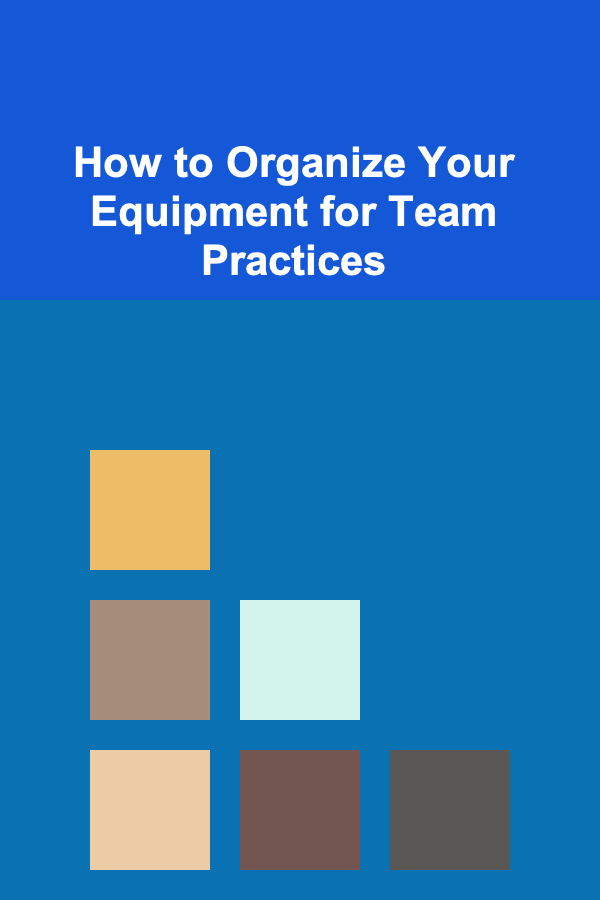
How to Create a Checklist for Migrating Blog Posts and Articles
ebook include PDF & Audio bundle (Micro Guide)
$12.99$6.99
Limited Time Offer! Order within the next:

Migrating blog posts and articles from one platform to another can seem like a daunting task. Whether you're transitioning from one content management system (CMS) to another, moving from a self-hosted blog to a hosted platform, or simply updating your website's structure, a successful migration requires careful planning. Without proper planning, it's easy to lose valuable content, miss important SEO optimizations, or create broken links that frustrate your audience.
In this actionable guide, we will walk you through how to create a comprehensive checklist for migrating blog posts and articles, ensuring that you cover all the critical steps involved in the process.
Step 1: Audit Your Existing Content
Before diving into the actual migration process, it's crucial to assess your current content. This will help you identify which posts are worth migrating, which need updating, and which can be discarded altogether.
Key Actions:
- List all posts and articles: Use your CMS's built-in tools to generate a list of all existing blog posts and articles.
- Check performance metrics: Analyze which posts are performing well in terms of traffic, engagement, and SEO. These should be prioritized for migration.
- Assess outdated content: Identify posts that are no longer relevant or need significant updating. This will allow you to avoid migrating content that's no longer useful.
- Identify high-value posts: Focus on posts that have a lot of inbound links, strong SEO rankings, or significant historical value.
The goal of this audit is to ensure you only migrate the content that matters, while preparing you to update or discard the rest.
Step 2: Choose Your New Platform and CMS
Choosing the right platform is critical to the success of your migration. Different platforms offer varying features, performance levels, and customization options. Take your time to research, considering how your new CMS will fit your content needs.
Key Actions:
- Evaluate CMS options: Depending on your current setup, platforms like WordPress, Squarespace, and Wix might be worth considering. You may also be moving to a custom CMS or a more specialized one.
- Review compatibility with SEO tools: Ensure that your new CMS supports all the SEO tools and plugins you need to maintain or improve your rankings.
- Check scalability: Choose a platform that can grow with your blog's content and audience, avoiding a need to migrate again in the near future.
- Consider design flexibility: If design matters to you, ensure the new platform allows for customizable themes or a smooth migration of existing designs.
Once you've decided on your new platform, confirm that it supports the features required for the migration, such as plugins, SEO integrations, and third-party integrations.
Step 3: Plan Your URL Structure
URL structure is a vital consideration for SEO and user experience. A poor migration could result in broken links and lost rankings.
Key Actions:
- Decide on a URL strategy: Decide whether you want to keep the same URL structure or make changes. Consistency in URLs is essential for SEO, but a new platform may require URL changes.
- Create URL redirects: If URLs must change, set up 301 redirects for all migrated pages. This will help prevent 404 errors and ensure that link equity is passed along to the new pages.
- Map old URLs to new URLs: Create a detailed mapping of old URLs to their new counterparts to facilitate the redirect process.
- Test redirects: After setting up the redirects, test them to ensure they are working as expected and that users are seamlessly redirected to the new URLs.
Properly managing URL structures during migration is crucial to maintaining SEO rankings and minimizing disruptions to your audience.
Step 4: Backup Your Current Content
Before proceeding with any changes, always back up your current content. This is a safety measure to ensure that if something goes wrong during migration, you have a copy of everything.
Key Actions:
- Export all content: Use the export functions within your CMS to create a backup of all blog posts, articles, and media files. This typically includes exporting HTML, media libraries, and metadata.
- Download important assets: Ensure that all images, videos, and downloadable files associated with blog posts are also backed up.
- Backup databases and configurations: If your content is stored in a database, export the database as well. Additionally, back up the configurations of your current CMS for reference during the migration.
This step ensures that you have access to your original content if anything goes wrong during the migration process.
Step 5: Export Your Content
Now that you've backed up your content and decided on your new platform, it's time to export your blog posts and articles.
Key Actions:
- Use CMS export tools: Most CMS platforms have built-in export features that allow you to download your content in a format that can be imported into the new platform.
- Export metadata: Ensure that you export important metadata such as categories, tags, post dates, and authors, as this can affect the organization and structure of your new site.
- Export media: Don't forget to export media files (images, videos, PDFs) that accompany the blog posts, as they need to be re-uploaded to the new platform.
- Review the export: Double-check that the export file includes all the relevant data and that there are no missing posts.
If your CMS doesn't provide a clean export tool, you may need to manually copy and paste content or look for third-party migration tools that suit your needs.
Step 6: Import Content into the New Platform
Once you've exported the content, it's time to import it into your new platform. The ease of this step will depend on the CMS you're moving to and the compatibility of the export format.
Key Actions:
- Import content via the CMS's import tool: Most CMS platforms have an import feature that allows you to upload your exported content. Follow the instructions carefully to ensure everything migrates smoothly.
- Re-upload media files: Manually upload images and other media files to the new platform. Be sure that they are linked correctly to the corresponding posts.
- Check for formatting issues: Content migration often results in formatting errors. After importing, go through your posts and ensure everything appears as it should, with correct headings, paragraphs, and images.
- Verify metadata: Ensure that categories, tags, and other metadata have been correctly imported to maintain the organization and structure of your site.
At this stage, it's important to test the imported content thoroughly to ensure everything works as expected.
Step 7: Update Internal and External Links
Broken links can be a major problem after migrating content. This step ensures that all internal and external links are updated and functioning properly.
Key Actions:
- Update internal links: Make sure that all internal links (links within your blog posts pointing to other posts on your site) point to the correct URLs after the migration.
- Check external links: If your blog posts reference external websites or partners, check that these links are still functional and relevant.
- Check for broken links: Use a link-checking tool to scan for any broken or missing links. Correct any broken links before going live.
- Re-link assets: If your images or media files have moved to different locations on the new platform, update the links to these assets within your posts.
Key Tools:
- Broken link checker tools like Screaming Frog or Ahrefs can help you quickly identify and fix broken links after migration.
Step 8: Optimize SEO Settings
SEO is a crucial factor in any website migration, and it must not be overlooked. The right settings will help you maintain search engine rankings and drive traffic to your new blog.
Key Actions:
- Update meta tags: Ensure that title tags, meta descriptions, and header tags (H1, H2, etc.) are correctly set up for all pages. These tags are critical for search engine optimization.
- Implement redirects: Set up 301 redirects for all migrated pages that have changed URLs, pointing them to the correct pages.
- Check sitemap: Update your sitemap to reflect the new URL structure and submit it to Google Search Console to speed up indexing.
- Analyze post-performance: Review your migrated posts' performance through Google Analytics to ensure that you aren't losing traffic or rankings.
SEO is an ongoing process, so keep monitoring your rankings and make adjustments as needed to optimize the performance of your migrated content.
Step 9: Test and Quality Control
Before officially launching your new platform, it's critical to run thorough tests to ensure that everything works as intended.
Key Actions:
- Test site speed: Site performance and load time are important for both user experience and SEO. Use tools like Google PageSpeed Insights to analyze and optimize site speed.
- Test mobile compatibility: Ensure that your migrated blog posts and articles are fully responsive on mobile devices.
- Check usability: Test the site navigation, layout, and search functions to ensure a smooth user experience.
- Perform a final audit: Conduct a final audit of the entire site to make sure no content or media has been lost in the migration process.
Once you've tested and reviewed your content, you're ready for the final launch.
Conclusion
Migrating blog posts and articles is a complex process, but with careful planning, a solid checklist, and methodical execution, you can ensure that the migration goes smoothly. Following these steps will help you preserve SEO rankings, avoid technical issues, and provide your audience with a seamless transition to the new platform. Whether you're making the move for performance reasons, design improvements, or better functionality, a successful migration will ensure that your blog continues to thrive in its new home.
Reading More From Our Other Websites
- [Home Budget 101] How to Stick to Your Home Budget During the Holiday Season
- [Home Lighting 101] How to Incorporate Floor Lamps into Your Home Decor for Functional Style
- [Weaving Tip 101] Weave Your Way to Serenity: Techniques for Turning Fabric into Focus
- [Needle Felting Tip 101] Step-by-Step Guide: Needle-Felting a Vibrant Sunset Meadow
- [Organization Tip 101] How to Manage Transportation Logistics for Field Trips
- [Home Cleaning 101] How to Clean Your Home Using Essential Oils
- [Survival Kit 101] Top 10 Survival Kit Essentials You Can't Afford to Miss
- [Home Holiday Decoration 101] How to Create a Stunning Holiday Tablescape for Your Guests
- [Organization Tip 101] How to Use a Rolling Cart for Craft Kit Mobility
- [Home Cleaning 101] How to Create a Checklist for Housekeeping Services

How to Make the Most of Your Laundry Room Space
Read More
How to Organize Your Equipment for Team Practices
Read More
How to Renovate Your Basement Into a Livable Space
Read More
How to Use App Development Platforms to Make Money
Read More
10 Tips for Maximizing Tax Deductions as a Small Business Owner
Read More
10 Tips for a Hiking Checklist for Beginners
Read MoreOther Products

How to Make the Most of Your Laundry Room Space
Read More
How to Organize Your Equipment for Team Practices
Read More
How to Renovate Your Basement Into a Livable Space
Read More
How to Use App Development Platforms to Make Money
Read More
10 Tips for Maximizing Tax Deductions as a Small Business Owner
Read More